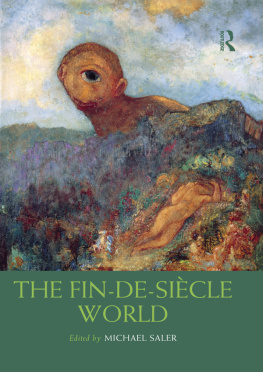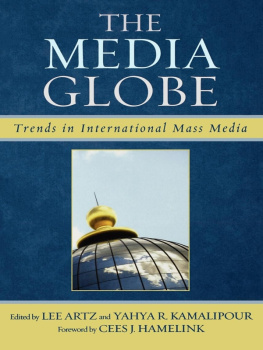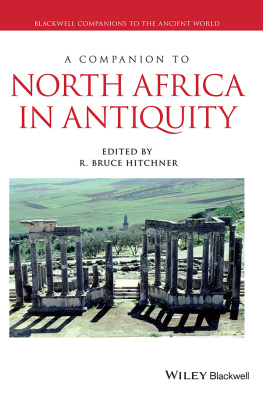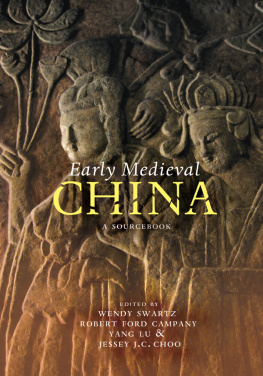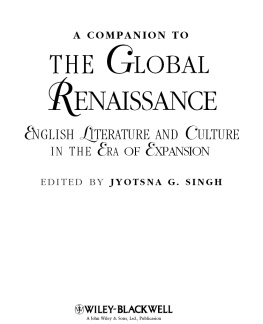Part II
Places
Chapter Thirty-Two
Gender and Sexuality
Ann Heilmann and Mark Llewellyn
Women love us for our defects. If we have enough of them they will forgive us everything, even our intellects
[T]rue If we women did not love you for your defects, where would you all be? You would be a set of unfortunate bachelors. Not, however, that that would alter you much. Nowadays all the married men live like bachelors, and all the bachelors like married men.
Fin De Sicle , murmured Lord Henry.
Fin du globe , answered [Lady Narborough].
I wish it were fin du globe , said Dorian Life is a great disappointment.
(Wilde 2007: 149)
Dorian Grays comment is often viewed as encapsulating the world-weariness of decadent life in the late nineteenth century. What has received less attention is the sense implied of the global nature of such experience. Lady Narboroughs introduction of du globe into the discussion is pertinent for an interrogation of gender and sexuality at the Fin De Sicle . Studies of the 1880s and 1890s have tended to focus on debates about women, and more recently masculinity, sexual identities and the political and personal battles for expression figured through bodies, behaviours and beliefs within largely European and Anglo-American contexts. With greater exposure to a plurality of exoticised or eroticised countries in the decadent imagination, however, the universal applicability of Western ideas of gender and sexuality came to be questioned. While this was a time of expanded travel, the period also saw increased instances of conflict for empires in tension. The literary fantasies of reverse invasion (Ledger and Luckhurst 2000: xvi) that emerged reflected a sense of the dangers as trading routes and systems were tested in the East and the dividing lines drawn up at the Berlin Conference in 1885 between the competing imperial powers. These contexts channelled a new energy into preserving imperial ideology even in the face of its own decline, and often with masculinity at stake in the project of protecting empires near and far (see the imperial Gothic of H. Rider Haggards She and Bram Stokers Dracula ).
This anxiety of ideological decline had a profound impact on understandings of cultural movements, with gender and sexuality becoming the battleground for the moral and mental constitution of Western civilisation. The Austrian-born Max Nordau claimed a degree of universality not only for his diagnosis of cultural decay but also more broadly for a world in self-destruction. Nordaus opening declaration in Degeneration (1892, first English translation 1993) signals the worldwide dimension of his verdict on the Fin De Sicle as an epoch heralding the Dusk of the Nations, in which all suns and all stars are gradually waning, and mankind with all its institutions and creations is perishing in the midst of a dying world (1993: 3). This is decay at a cosmological level. Yet Nordaus examples of global weariness reaching its conclusion in apocalyptic, eschatological meanings (Bradley 2010) are Western and predominantly European. European introspection appears often to have trumped more globalist as well as regionally diverse understandings of the contexts of the period.
This is not altogether surprising. For progressives and decadents alike in the 1890s one might perceive such inward and domestic rather than outward and foreign self-examinations as part of a rebellion against the previous generations and their expansionist colonial impulses. Identifying when the world experienced the Fin De Sicle is therefore a complex task. Whereas the Fin De Sicle and the 1880s and 1890s have become synonymous in a European context, and often incorporate the broader periodicity of the century, spanning the French belle poque as well (McAuliffe 2011), charting when the Fin De Sicle is experienced in terms of cultural replication and similarities of style, concern and anxieties is harder to determine in its international dimension. To use the twin figures of Anglo-American Fin-De-Sicle sexual anarchy, the New Woman and the dandy (Showalter 1991), for example, raises questions about the temporal framing of the period across different national and ethnic settings. The New Woman appeared in non-Western cultures like Japan and even in a European framework at divergent periods after the centurys turn, in the 1910s or 1920s (Heilmann and Beetham 2004). In making international comparisons, therefore, we need to be mindful of the risk of global reductionism, seeing continuity in circumstance and influence in happenstance. Thus, while David Der-wei Wangs Fin-De-Sicle Splendor: Repressed Modernities of Late Qing Fiction, 18491911 shares a terminology and a periodic framework resonant with the Western Fin De Sicle , his study draws pointed attention to the divergent and often contradictory pressures at work in the Chinese context of the time.
As a result, the global Fin De Sicle proves an arresting area of research: intriguing, but also problematic as we seek to explore the international dimensions of such localised paradigms and cultural specificities as gender and sexuality. The partial way to handle this is to accept the limitations of the global as a unifying point of critique and embrace the dominant mode. Christopher Bayly sets out the dilemma and its solution in his stated objective to chart the interdependence of world events, while allowing for the brute fact of Western domination [even though] over large parts of the world, this European domination was only partial and temporary (2004: 3). Similarly, Bryan Turner suggests that while we can have some view on the global nature of the Fin De Sicle we also need some understanding of the local circumstances and in particular on the indigenous circumstances within national cultures (1994: 153).
An important insight that has emerged from Regenia Gagniers Global Circulation project for Literature Compass is that linear approaches to the transnational circulation of literature seeking to identify repetition and assimilation can be misleading, given that the complexity of cultural models is more diverse than influence or spread of ideas, residing instead in cultural resonances across time periods and geographic range. Gagnier (2010) places new emphasis on reconsidering the diversity of global understandings and cultural cross-currents of the late nineteenth century. Underlining the significance of the nomadic nature of ideas as they have permeated, non-synchronically, across borders, Gagniers investigation of how concepts travel transculturally resonates with critical perceptions of decadence as a Western phenomenon. It may be considered somewhat ironic that decadence, imagined as it was through decay and non-reproduction, should provide a model of cultural transmission. It is, after all, a concept framed by sterility and dissolution.
Other key markers of decadence excess, affectation and ornamentation point to the gendered contexts of the movement which, as Roger Luckhurst comments, was associated with ostentatious and pointless display. The Decadent became absorbed in an obscure, private, and perverse world. The Decadent style is encrusted with ornament, weighed down with abstruse learning and Latinate constructions. It revels in artifice; it despises the natural and virile. (2005: xvii) The revulsion from the virile and the desire to embrace the unnatural are key to the ways in which decadence and its self-assertion through self-denying sexuality underpin the first strand we wish to explore: sex and celibacy.
Sex and The Single Life
Lady Narboroughs comment about unfortunate bachelors in Wildes novella conjures up the contrast between respectable irregularity and its dangerous opposite of disrespectable singularity, between the cover of marriage and the exposure of celibacy (or worse). In the pivotal year of 1895 the Anglo-Irish novelist George Moore published Celibates , a collection of three novellas exploring questions of non-reproductive sexuality, the complexities of gender and sexual desire, and the yearning for a life aesthetic and ascetic. Featuring as his three protagonists a half-hearted New Woman, a repressed homosexual and a convent-educated daughter from a broken middle-class home, Moores tales challenge the notion of decadent sexuality as explicit or overtly expressive. When thinking of Fin-De-Sicle gender and sexuality, celibacy does not immediately come to mind. Yet Moores stories and his revisions of them into the late 1920s are more of the period than we may assume. Indeed, one of the core concerns of social commentators at the time was the lack of sexual activity taking place rather than the excess of it. Thus a debate about The Degradation of Woman conducted in the Humanitarian in 1896 between the Catholic biologist St George Mivart and the science writer and novelist Grant Allen articulated male anxiety about that indifference towards, or positive aversion to, intimate conjugal relations which so many wives seem now to experience as a result of a rapidly spreading fixed idea that to submit themselves to those conjugal relations, when not prompted to do so by their own feelings, is for them a DEGRADATION! (9: 251, in Heilmann 1998: II). Allen, who had caused a sensation with his free (extramarital) love novels The Woman Who Did and The British Barbarians (both 1895), shared Mivarts panic about female sexual abstinence, if from the opposite spectrum, warning that because of outdated virginity and chastity norms England to-day is full of celibate women to whom their condition is, rightly and naturally, a wrong and a grievance (9: 34142, in Heilmann 1998: II).

